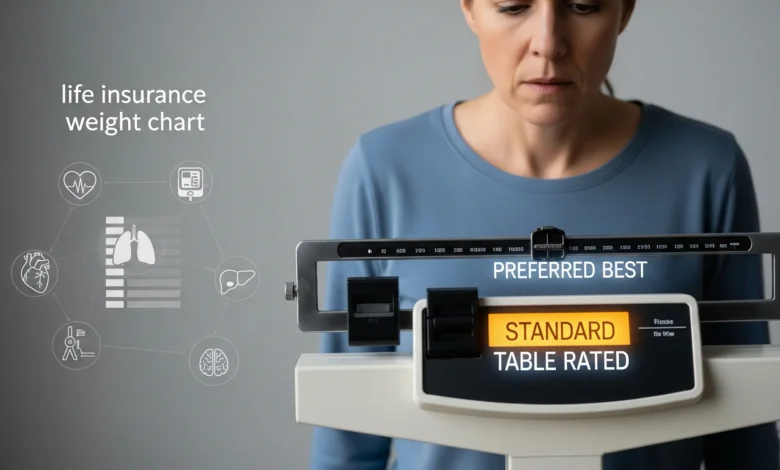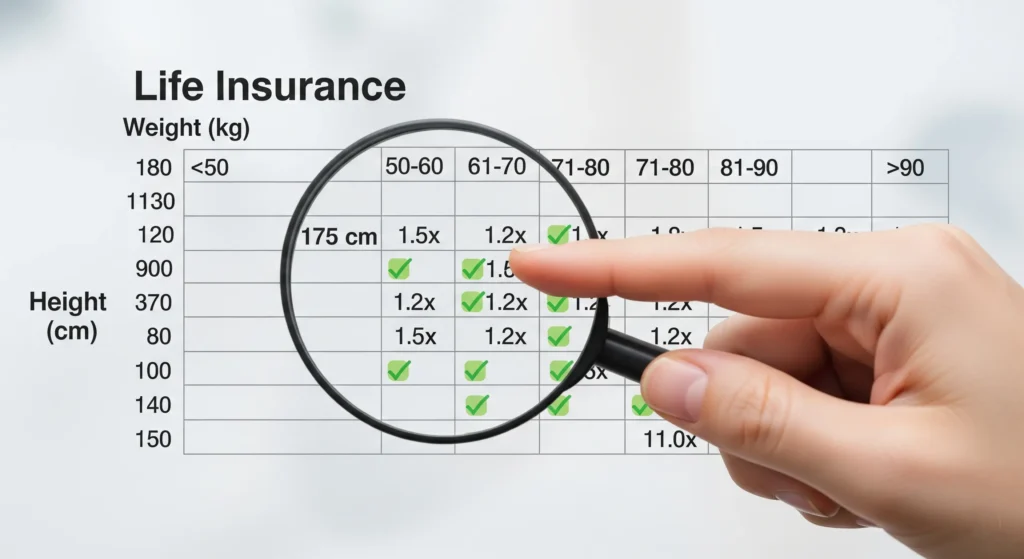Your Friend’s Guide to Life Insurance Weight Charts (And Why You Shouldn’t Panic!)

Hey there! So you’re worried about how your weight might mess with your life insurance rates? I get it – and honestly, you’re not alone in this. Like, SO many people stress about this stuff, but here’s the thing: you’ve got way more options than you think!
Look, I’m gonna break down everything you need to know about how life insurance companies look at your height and weight. We’ll chat about those mysterious life insurance weight charts (spoiler alert: they’re not as scary as they sound), how your rates get figured out, some sneaky tips to boost your chances, and backup plans for literally everyone – no matter what size you are.
Here’s what I want you to remember: yes, your weight matters to insurance companies, but it’s rarely going to completely slam the door in your face. Once you understand how this whole thing works, you can score decent coverage without breaking the bank.
Why Insurance Companies Are So Nosy About Your Weight (Spoiler: It’s All About the Money)
Okay, let’s be real here – insurance companies care about your weight because they’re professional worriers who get paid to calculate risk. And I mean that in the nicest way possible!
They’ve got mountains of data showing that folks who are significantly overweight have higher chances of developing certain health issues. It’s not personal – it’s just math. Kinda like how your car insurance goes up if you get speeding tickets, except with your body instead of your driving record.
The Health Stuff They Worry About
So what exactly are they freaking out about? Well, here’s the list of things that pop up more often when someone’s carrying extra weight:
Heart Problems are their biggest concern. We’re talking high blood pressure, heart disease, strokes, and wonky cholesterol levels. Since heart disease is still the #1 killer in America, you can see why they pay attention to this stuff.
Diabetes is another biggie. Type 2 diabetes loves to hang out with extra weight, and it can cause all sorts of complications down the road – kidney problems, nerve damage, and circulation issues. Not fun stuff.
Other Random Things they track include gallbladder disease (ouch), arthritis, sleep apnea (the dangerous snoring disorder), liver problems, kidney issues, and some types of cancer. They’ve got a whole list of “stuff that happens more when you weigh more.”
How This Hits Your Wallet
When insurance companies see these risks, they stick you in a higher risk group, which means higher premiums. It’s like they’re saying, “Hey, you might cost us more money later, so we need more money now.” Fair? Maybe not, but that’s how the game works.
But here’s the good news – weight is just ONE piece of the puzzle. Tons of people with higher weights still get great rates when everything else looks good!
Cracking the Code: What’s a Life Insurance Weight Chart Anyway?

Alright, let’s talk about these mysterious life insurance weight charts (some people call them “build charts” – sounds fancier, right?). Think of them like those height requirements at amusement parks, except instead of “you must be this tall to ride,” it’s “you must weigh between this and that to get our best rates.”
How They Use These Charts
Insurance companies use these charts as their starting point, but they’re not the be-all and end-all. It’s more like a first impression – they look at the chart, then dig deeper into your whole story before making final decisions.
The Inside Scoop on Life Insurance Weight Charts
Here’s what most people don’t know about these charts:
Every Company’s Different: This is HUGE! One company might say “nope” to your height and weight combo while another says “welcome aboard!” It’s like online dating – you gotta find your match. This is why having someone shop around for you is pure gold.
The Type of Policy Matters: If you’re getting the full medical exam treatment, the weight limits are usually more generous than those of “no exam” policies. Makes sense – if they’re not gonna poke and prod you, they want to be extra careful about who they accept.
Guy vs. Girl Charts: Some companies have separate charts for men and women; others use one chart for everyone. The unisex ones sometimes work out better for women – go figure!
Too Skinny is Also a Thing: Plot twist – you can also get dinged for being too light for your height, too short, or too tall. They want you right in that Goldilocks zone.
Some Policies Don’t Care At All: Here’s a secret – certain types of life insurance (like some burial policies) don’t have weight limits. At all. Mind blown, right?
What These Charts Look Like
Picture a table with heights on one side and weight ranges on the other. So if you’re 5’6″, you might see something like: best rates for 110-145 lbs, good rates for 110-160 lbs, standard rates for 110-180 lbs. The ranges get bigger as the rates get higher – pretty logical when you think about it.
BMI vs. Insurance Weight Charts: They’re Not the Same Thing!
Okay, this is where a lot of people get confused. You know that BMI thing your doctor talks about? Yeah, that’s different from what insurance companies use, and it’s super important to understand why.
BMI 101 (The Quick Version)
BMI is just a simple math formula that puts you in categories:
- Underweight: Under 18.5
- Normal: 18.5-24.9
- Overweight: 25.0-29.9
- Obese: 30.0 and up
The formula is: (Your weight ÷ (Your height in inches squared)) × 703. Or just Google “BMI calculator” – way easier!
Why Insurance Companies Think BMI is Kinda Lame
Here’s the thing – BMI doesn’t know if you’re built like a linebacker or a marathon runner. It just sees height and weight and makes assumptions. A super-fit athlete could have a “high” BMI because muscle weighs more than fat, but they’re not unhealthy.
Insurance Weight Charts Are Smarter
Life insurance companies figured this out and created their charts that are usually way more forgiving than BMI categories. I’ve seen people with a BMI of 25.8 (technically “overweight”) still get the best rates because the insurance company’s chart said they were fine.
The cool thing is these charts work alongside all your other info – your health, lifestyle, family history – to paint a complete picture instead of just looking at one number.
The Underwriting Game: What Happens Behind the Scenes

Let’s pull back the curtain on this whole underwriting thing. It’s basically where they decide if they like you enough to insure you and how much they’re gonna charge.
It’s Not Just About Weight (Thank Goodness!)
These underwriters look at EVERYTHING:
Basic Stuff like your age and gender (sorry, can’t change those!)
Your Health Story – current issues, past problems, medications you take. Having something doesn’t automatically disqualify you, but they wanna know about it.
Lifestyle Choices – smoking is a big one (even if you only smoke when you drink), how much you drink, and any recreational drug use. They’re not judging… okay, they are, but it’s for business reasons.
Your Job and Hobbies – if you’re a professional lion tamer or weekend skydiver, that’s gonna come up in conversation.
Family Tree – they wanna know if heart disease, cancer, or diabetes runs in your family. It’s like they’re looking into a crystal ball of your genetic future.
Money Stuff – for big policies, they make sure the amount makes sense with your income. Can’t have people insuring themselves for millions when they make minimum wage – that’s just suspicious.
The Rate Classes (AKA Your Report Card)
Think of these like grades in school:
Preferred Best/Preferred Plus = A+ students. Perfect health, perfect weight, probably floss daily. These folks get the cheapest rates but the strictest requirements.
Preferred = A students. Still great rates with a little more wiggle room. Most healthy people with minor weight concerns can land here.
Standard Plus = B+ students. Good rates with more flexibility. Maybe you’ve got well-controlled high blood pressure, or you’re a few pounds over the “preferred” limit.
Standard = B students. Still totally respectable! If weight is your main “issue” and everything else looks good, you’ll probably end up here. Even mild obesity (BMI under 31) can qualify if you’re otherwise healthy.
Table Ratings = C students and below. This is where they start adding surcharges. Table 2 might mean you pay 150% of normal rates, and Table 4 could be 200%. Not ideal, but hey, you’re still covered!
The Cool New Thing: Underwriting Credits
Some companies are getting smarter about this stuff. They’ll look at your whole picture and say, “Okay, you’re 20 pounds overweight, BUT you exercise regularly and your blood pressure is perfect, so we’ll call it even.” Companies like AIG, Banner, Prudential, and John Hancock are doing this more often. It’s like getting extra credit in school!
Insider Tips to Boost Your Chances (And Maybe Save Some Cash)
Alright, here’s where I share the good stuff – the tricks that can make a difference in your approval odds and rates.
Get Yourself an Insurance Agent (The Independent Kind)
This is honestly the best money you’ll ever spend (they get paid by the insurance company, not you). Independent agents work with tons of different companies – sometimes 50 or more – and they know which ones are cool with your specific situation.
It’s like having a friend who knows everyone at the party and can introduce you to the right people. They’ll shop your application around and find your “type” – the company that’s gonna love what you’re bringing to the table.
Nail Your Medical Exam
If you’re getting the full medical exam, here are some tricks that might help:
Schedule It Early – book that appointment for the first thing in the morning. You’ll weigh less after fasting all night, and your blood pressure is usually better, too.
Dress Light – wear your lightest clothes. Every pound counts if you’re right on the edge of a weight category. Skip the heavy boots and chunky jewelry.
Watch What You Eat – avoid salty, heavy meals for a day or two before. Salt makes you retain water, which shows up on the scale and can bump up your blood pressure.
Stay Hydrated – but don’t chug water right before. You want to make it easy for them to get blood and urine samples, but you don’t want to be uncomfortably full.
The Weight Loss Strategy (If You’re Going That Route)
If you’re thinking about losing some weight before applying, here’s what you need to know:
Even Small Changes Matter – losing just enough to drop into a better category can save you serious money over the life of your policy. We’re talking hundreds or thousands of dollars!
The 50% Rule is Sneaky – if you’ve lost more than 10 pounds in the past year, some companies will only give you half credit for that loss. They want to make sure it’s gonna stick, so they might average your weight over the past year or two.
Smart Timing – here’s a pro move: apply for the policy first, then schedule your exam 2-3 weeks out. This gives you a goal to work toward without delaying your coverage unnecessarily.
Think Beyond the Scale – regular exercise and better eating habits will improve your blood pressure, cholesterol, and blood sugar, too. That’s bonus points in the underwriting game!
What About Those New Weight Loss Drugs?
With Ozempic and Wegovy being everywhere these days, here’s how insurance companies handle them:
Just for Weight Loss – if you’re taking them purely to lose weight, they’ll use standard weight guidelines with your current weight.
For Diabetes – if it’s prescribed for diabetes management, they’ll follow their diabetes rules, which might be stricter.
Timing Matters – if you just started (within the last year), they might average your weight. If you’ve been on them longer, they’ll usually just use your current weight.
What If You Get Bad News? (Don’t Panic – You’ve Got Options!)

So let’s say you applied and got either denied or hit with crazy high rates because of your weight. First of all, don’t take it personally – it happens to good people all the time. And second, you’ve still got moves to make!
Don’t Wait Around
The worst thing you can do is nothing. Even if you can’t get the best rates right now, getting SOME coverage is better than having none at all. You can always apply again later if your situation improves, but you can’t turn back time if something happens while you’re uninsured.
Your Backup Options
Final Expense Insurance – this is like the friendly cousin of regular life insurance. It’s designed to cover funeral costs and final bills, usually doesn’t require a medical exam, and the weight requirements are super relaxed or non-existent. Yeah, it’s more expensive per dollar of coverage, but it’s there when you need it. Usually for folks 50-80 years old.
Guaranteed Acceptance – this is the “we’ll take anyone” option. No health questions, no medical exam, no weight limits. The catch? It’s expensive, and there’s usually a two-year waiting period where they’ll only pay back your premiums (plus interest) if you die, not the full death benefit. But after those two years, you’re golden.
Group Life at Work – if your employer offers life insurance, jump on it! They usually can’t turn you down for health reasons, and sometimes it’s free or super cheap. The downside is that it’s usually not much coverage, and it goes away when you leave the job. Better than nothing, though!
Accidental Death Insurance – this only pays if you die in an accident (not from illness), but it’s cheap and easy to get. Think of it as better-than-nothing insurance while you work on other options.
Taking Control of Your Insurance Future (You’ve Got This!)
Look, here’s the bottom line: your weight is a factor, but it’s not the whole story. Understanding how life insurance weight charts work puts you in the driver’s seat instead of just hoping for the best.
The insurance world is huge and diverse. What one company thinks is a deal-breaker, another company might shrug off completely. This is why persistence (and good help) usually wins in the end.
Don’t wait for the “perfect” time to apply. Even if you can’t get rock-bottom rates today, protecting your family now is what matters. You can always try again later as things improve, but you can’t go back and protect the time you spent uninsured.
Working with a good independent agent is like having a knowledgeable friend in your corner. They know which companies are gonna be cool with your situation, they can compare tons of options, and they’ll help you find something that fits both your needs and your budget.
The life insurance weight chart doesn’t have to be your enemy. With the right approach and some professional backup, you can find coverage that works for you while you focus on whatever health goals you’ve got. Don’t let weight worries keep you from taking care of your family’s financial future – there’s a solution out there with your name on it.
Ready to Get Started?
Why not grab a free quote and see what’s out there? No commitments, no pressure – just some real numbers to work with. A good agent can walk you through your options and help you figure out the best game plan for your specific situation. Trust me, it’s way less scary than you think!




